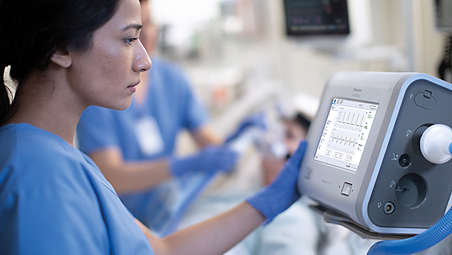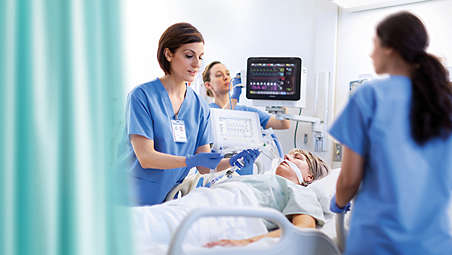Especificações
- Modos de ventilação
-
Modos de ventilação A/C-PC - Assisto controlada (controle da pressão)
A/C-VC - Assisto controlada: (controle do volume)
CPAP - Pressão positiva contínua das vias aéreas
PSV - Ventilação com pressão de suporte
S/T - Ventilação espontânea/temporizada
SIMV-PC - Ventilação mandatória intermitente sincronizada (controle da pressão)
SIMV-VC - Ventilação mandatória intermitente sincronizada (controle do volume)
-
- Características físicas
-
Características físicas Weight - 6,3 kg com bateria hot swap
Size - P 19,3 cm x L 28,6 cm x A 24,5 cm
Screen dimensions - 20,32 cm
Ingress protection - IP22: proteção contra objetos do tamanho de um dedo e respingos de água quando inclinado a 15 graus.
-
- Oxigênio
-
Oxigênio Low flow - 0 a 30 l/min; máximo de 10 psi
High pressure - 280 a 600 kPa (41 a 87 psi)
-
- Parâmetros do paciente medidos e exibidos
-
Parâmetros do paciente medidos e exibidos Tidal volume (Vti or Vte) - 0 a 2.000 ml
Minute ventilation (MinVent) - 0 a 30 l/min
Leak - 0 a 200 l/min
Respiratory rate (RR) - 0 a 90 RPM
Peak inspiratory flow PIF - 0 a 200 l/min
Peak inspiratory pressure PIP - 0 a 90 cmH₂O
Mean airway pressure - 0 a 90 cmH₂O
Spontaneous triggered breaths - 0 a 100%
I:E ratio - 9,9:1 a 1:9,9
Dynamic compliance (Dyn C) - 1 a 100 ml/cmH₂O
Dynamic resistance (Dyn R) - 5 a 200 cmH₂O/l/s
Dynamic plateau pressure - 0 a 90 cmH₂O
Auto-PEEP - 0 a 20 cmH₂O
FiO₂ with FiO₂ sensor - 21 a 100%
SpO₂ with pulse oximeter - 0 a 100%
Pulse rate with pulse oximeter - 18 a 321 rpm
EtCO₂ with CO₂ accessory - 0 a 150 mmHg
-
- Elétricas
-
Elétricas AC input voltage - 100 V a 240 V, 50/60 Hz, 1,7 a 0,6 A
DC input voltage - 12/24 V 6,5 A
Li-ion batteries - Baterias Li-Ion interna/hot swap: autonomia nominal total de funcionamento de 7,5 horas cada (de acordo com a norma IEC 80601-2-72)
Charge time for battery - Tempo de carga da bateria destacável e da bateria interna: de 0 a 80%: 2,5 horas; de 0 a 100%: 3,5 horas respectivamente
-
- Alarmes
-
Alarmes Inspiratory Pressure - 1 a 90 cmH₂O
Tidal Volume - DESLIGADO, 10 a 2.000 ml
Minute Ventilation - DESLIGADO, 0,2 a 30 l/min
Respiratory Rate - DESLIGADO, 1a 90 RPM
Circuit Disconnection - DESLIGADO, 5 a 60 s
Apnea Interval - 5 a 60 s
-
- Ambiente
-
Ambiente Operating Conditions - 0°C a 40°C, 5% a 90% UR (sem condensação), pressão atmosférica: 62 a 106 kPa, altitude: -390 a 4,000 metros
Transient operating temp - -20°C a 50°C
Storage temperature - Temperatura: -25°C a 70°C Umidade relativa: 5% a 93% UR, sem condensação
-
- Controles
-
Controles AVAPS with passive circuit - apenas para os modos PSV, S/T e A/C-PC
Tidal volume - 35 a 2.000 ml nos circuitos de ramo duplo e fluxo ativo e 50 a 2.000 ml em circuitos dePAP passivos
Breath rate - 0 a 80 RPM
PEEP - 0 a 35 cmH₂O para circuitos ativos, 3 a 25 cmH₂O para circuitos passivos
EPAP/CPAP - 3 a 25 cmH₂O
IPAP - 3 a 60 cmH₂O
Pressure support/control - 0 a 60 cmH₂O
Inspiratory time - 0,3 a 5,0 s
Rise time - 0 a 6 s
Triggering and cycling - Desligado, AutoTrak, AutoTrak Sensitive e Acionamento do Fluxo
Flow trigger sensitivity - 0,5 a 9 l/min
Flow cycle sensitivity - 10 a 90% do pico de fluxo
Flow pattern - Quadrado, intensificação
FiO₂ - 21 a 100%
Inspiratory time min/max - 0,3 a 3,0 s
Backup ventilation - LIGADO - DESLIGADO
-
- Normas
-
Normas General - IEC 60601-1-1 Equipamento médico elétrico. Parte 1-1: requisitos gerais de segurança
Collateral - IEC 60601-1-11 para Ambientes de Cuidado Domiciliar de acordo com o uso operável em trânsito
Particular - ISO 80601-2-72 Parte 2-72 ISO 80601-2-12 Parte 2-12 ISO 80601-2-61 Parte 2-61 ISO 80601-2-55 Parte 2-55
Wireless communication - Bluetooth v4.1, ISO/IEC 18092:2013, 21481 ed. 2.0, 14443 ed. 2.0,Padrão WLAN: IEEE 802.11(2012)b/g/n
-
- Modos de ventilação
-
Modos de ventilação A/C-PC - Assisto controlada (controle da pressão)
A/C-VC - Assisto controlada: (controle do volume)
-
- Características físicas
-
Características físicas Weight - 6,3 kg com bateria hot swap
Size - P 19,3 cm x L 28,6 cm x A 24,5 cm
-
- Modos de ventilação
-
Modos de ventilação A/C-PC - Assisto controlada (controle da pressão)
A/C-VC - Assisto controlada: (controle do volume)
CPAP - Pressão positiva contínua das vias aéreas
PSV - Ventilação com pressão de suporte
S/T - Ventilação espontânea/temporizada
SIMV-PC - Ventilação mandatória intermitente sincronizada (controle da pressão)
SIMV-VC - Ventilação mandatória intermitente sincronizada (controle do volume)
-
- Características físicas
-
Características físicas Weight - 6,3 kg com bateria hot swap
Size - P 19,3 cm x L 28,6 cm x A 24,5 cm
Screen dimensions - 20,32 cm
Ingress protection - IP22: proteção contra objetos do tamanho de um dedo e respingos de água quando inclinado a 15 graus.
-
- Oxigênio
-
Oxigênio Low flow - 0 a 30 l/min; máximo de 10 psi
High pressure - 280 a 600 kPa (41 a 87 psi)
-
- Parâmetros do paciente medidos e exibidos
-
Parâmetros do paciente medidos e exibidos Tidal volume (Vti or Vte) - 0 a 2.000 ml
Minute ventilation (MinVent) - 0 a 30 l/min
Leak - 0 a 200 l/min
Respiratory rate (RR) - 0 a 90 RPM
Peak inspiratory flow PIF - 0 a 200 l/min
Peak inspiratory pressure PIP - 0 a 90 cmH₂O
Mean airway pressure - 0 a 90 cmH₂O
Spontaneous triggered breaths - 0 a 100%
I:E ratio - 9,9:1 a 1:9,9
Dynamic compliance (Dyn C) - 1 a 100 ml/cmH₂O
Dynamic resistance (Dyn R) - 5 a 200 cmH₂O/l/s
Dynamic plateau pressure - 0 a 90 cmH₂O
Auto-PEEP - 0 a 20 cmH₂O
FiO₂ with FiO₂ sensor - 21 a 100%
SpO₂ with pulse oximeter - 0 a 100%
Pulse rate with pulse oximeter - 18 a 321 rpm
EtCO₂ with CO₂ accessory - 0 a 150 mmHg
-
- Elétricas
-
Elétricas AC input voltage - 100 V a 240 V, 50/60 Hz, 1,7 a 0,6 A
DC input voltage - 12/24 V 6,5 A
Li-ion batteries - Baterias Li-Ion interna/hot swap: autonomia nominal total de funcionamento de 7,5 horas cada (de acordo com a norma IEC 80601-2-72)
Charge time for battery - Tempo de carga da bateria destacável e da bateria interna: de 0 a 80%: 2,5 horas; de 0 a 100%: 3,5 horas respectivamente
-
- Alarmes
-
Alarmes Inspiratory Pressure - 1 a 90 cmH₂O
Tidal Volume - DESLIGADO, 10 a 2.000 ml
Minute Ventilation - DESLIGADO, 0,2 a 30 l/min
Respiratory Rate - DESLIGADO, 1a 90 RPM
Circuit Disconnection - DESLIGADO, 5 a 60 s
Apnea Interval - 5 a 60 s
-
- Ambiente
-
Ambiente Operating Conditions - 0°C a 40°C, 5% a 90% UR (sem condensação), pressão atmosférica: 62 a 106 kPa, altitude: -390 a 4,000 metros
Transient operating temp - -20°C a 50°C
Storage temperature - Temperatura: -25°C a 70°C Umidade relativa: 5% a 93% UR, sem condensação
-
- Controles
-
Controles AVAPS with passive circuit - apenas para os modos PSV, S/T e A/C-PC
Tidal volume - 35 a 2.000 ml nos circuitos de ramo duplo e fluxo ativo e 50 a 2.000 ml em circuitos dePAP passivos
Breath rate - 0 a 80 RPM
PEEP - 0 a 35 cmH₂O para circuitos ativos, 3 a 25 cmH₂O para circuitos passivos
EPAP/CPAP - 3 a 25 cmH₂O
IPAP - 3 a 60 cmH₂O
Pressure support/control - 0 a 60 cmH₂O
Inspiratory time - 0,3 a 5,0 s
Rise time - 0 a 6 s
Triggering and cycling - Desligado, AutoTrak, AutoTrak Sensitive e Acionamento do Fluxo
Flow trigger sensitivity - 0,5 a 9 l/min
Flow cycle sensitivity - 10 a 90% do pico de fluxo
Flow pattern - Quadrado, intensificação
FiO₂ - 21 a 100%
Inspiratory time min/max - 0,3 a 3,0 s
Backup ventilation - LIGADO - DESLIGADO
-
- Normas
-
Normas General - IEC 60601-1-1 Equipamento médico elétrico. Parte 1-1: requisitos gerais de segurança
Collateral - IEC 60601-1-11 para Ambientes de Cuidado Domiciliar de acordo com o uso operável em trânsito
Particular - ISO 80601-2-72 Parte 2-72 ISO 80601-2-12 Parte 2-12 ISO 80601-2-61 Parte 2-61 ISO 80601-2-55 Parte 2-55
Wireless communication - Bluetooth v4.1, ISO/IEC 18092:2013, 21481 ed. 2.0, 14443 ed. 2.0,Padrão WLAN: IEEE 802.11(2012)b/g/n
-
- ** Autonomia nominal de funcionamento segundo o método da Comissão Eletrotécnica Internacional (7,5 horas/bateria). O tempo de carga da bateria destacável de 0 a 80% é de 2,5 horas; o tempo de carga da bateria interna de 0 a 100% é de 3,5 horas.




